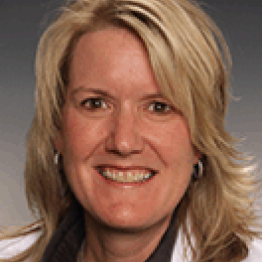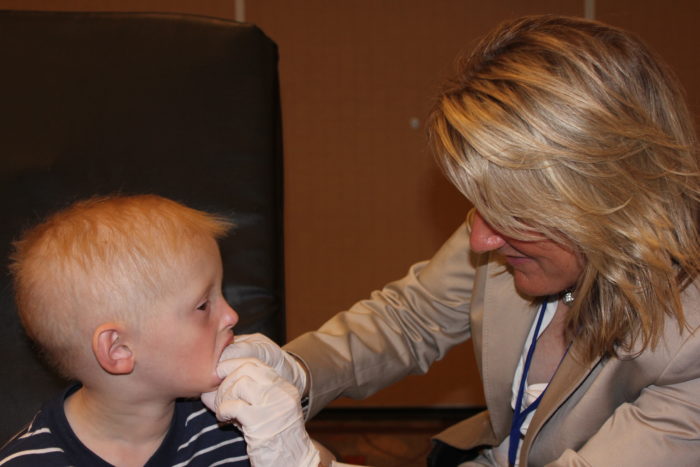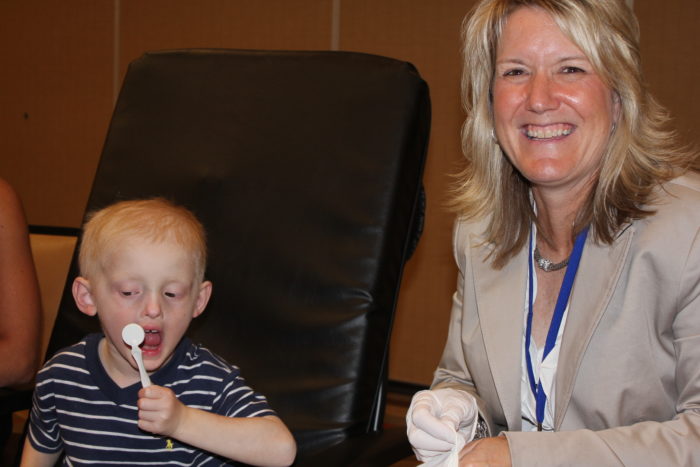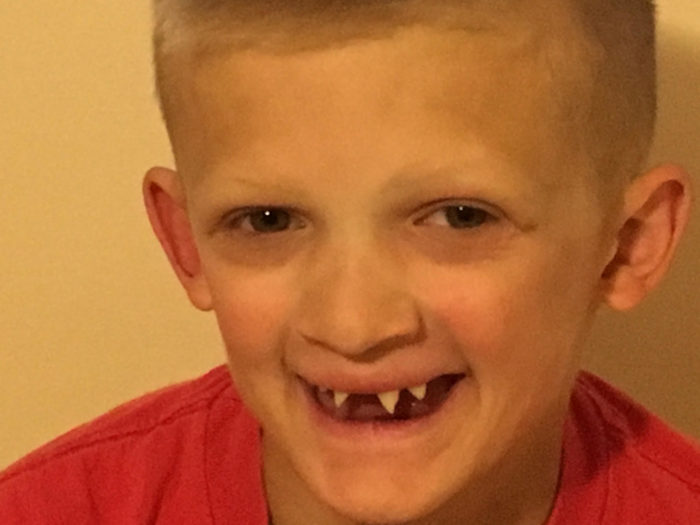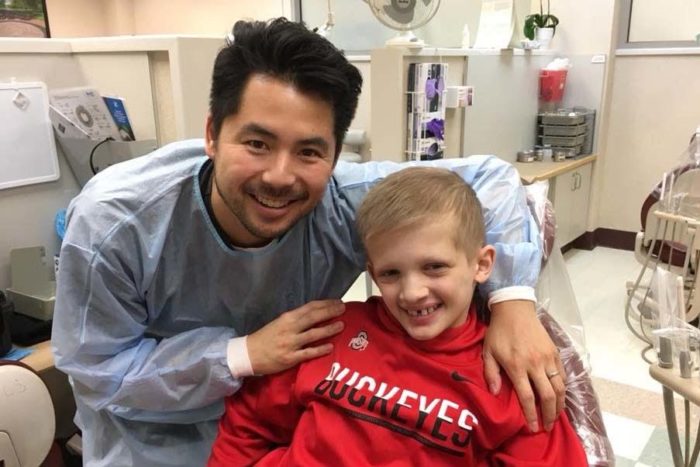Our ectodermal dysplasias community loves a good dentist, don’t we? Diagnosing and treating the complex dental issues caused by the conditions isn’t easy. So, when we find a dentist who not only understands the conditions but is compassionate and dedicated, too, we celebrate!
That’s why we are proud to spotlight Dr. Lisa Knobloch who leads our Dental Treatment Center at The Ohio State University College of Dentistry. For 15 years, we have worked together to provide individuals affected by ectodermal dysplasias with the dental care they need.
“Dr. Knobloch has been a champion of the ectodermal dysplasias community for a long time and we couldn’t be more grateful,” said Mary Fete, executive director for the National Foundation for Ectodermal Dysplasias (NFED).
Meet Dr. Lisa
Dr. Knobloch is a 26-year practicing dentist, professor and researcher.
“My responsibilities include clinical teaching in the predoctoral clinics where I supervise the third and fourth year dental students and graduates teaching in the Advanced Prosthodontics Program,” she said. “I also teach in the pre-clinic where I direct two courses, one in complex treatment planning and the other is implant dentistry.”
Like most dentists, Dr. Knobloch first learned about ectodermal dysplasia in a pathology course in dental school where the learning experience is in the classroom and on a very basic level.
“When I began my Advanced Prosthodontic Residency Program, I received a patient that was previously diagnosed with ectodermal dysplasia. He was six years old and he changed my professional mindset. I remember wanting to learn more about his condition and really wanting to do whatever I could to help him. I read whatever literature I could find to learn whatever I could. As young dentists especially, we can be very ‘procedure driven.’ It is a great moment when we realize that we can really help someone.”
Making a Difference
And helping someone – and the NFED – is what she’s doing. Over the years, we have asked her to help with our mission in many ways, and she always says yes.
“This is the one area in my profession where I can help make a difference. Treating a patient with an ectodermal dysplasia is so much more than completing a dental procedure. It is providing dental care at various stages of dental development, various stages of social development and helping them through important milestones in life as they journey towards the rehabilitation of their dental condition.”
Dr. Knobloch says she has enjoyed a long relationship with NFED for the past 15 years.
“The NFED is an amazing organization. I work with patients who have various craniofacial conditions. The NFED is by far the biggest advocate for their kids. They advocate on a national level and state level. They also offer resources on a very personal level. The Dental Treatment Center program is such a well-planned resource in that it assists individuals in finding quality care at a facility that is prepared to offer services for patients with a unique set of needs.”
How It All Began
The NFED-OSU partnership began in 2003 when we convened dental experts from across the United States to brainstorm solutions for how we could increase dental treatment options for families with ectodermal dysplasias.
“Early in my career, as I began to treat more patients affected with ectodermal dysplasias. I began to develop presentations to share my knowledge and experiences,” Knobloch said. “The Chair of our Pediatric Dentistry Department was sending one of his faculty to a special meeting on access to care for patients with ectodermal dysplasia. He recommended that I be one of the representatives from The Ohio State University College of Dentistry.
I remember participating in the meeting, meeting [NFED Founder] Mary Kaye Richter and Mary Fete. This first meeting and experience ignited my passion to want to do more. Since that time, I have started a Dental Treatment Center at Ohio State, lectured for the foundation when they have asked me to and participated in patient exams at the annual Family Conference.”
OSU Dental Treatment Center
For the last decade, numerous families have flocked to the OSU Dental Treatment Center to get treatment. According to Dr. Knobloch, the exact number is hard to calculate since they see these patients for many years.
“It is not uncommon for us to start treatment at a very young age before kindergarten and treat them through the many transitions of growth. We always have patients in active treatment and not a week goes by without treatment appointments.”
The NFED created a network of Dental Treatment Centers across the United States to increase our families’ access to quality care. Universities like OSU are able to offer a team of dental care specialists all in one location.
“What
sets our program apart from a private practice experience is the ability for
the patient to see the different dental specialists in the same facility,”
Knobloch said. “Often, these appointments can be coordinated on the same day.
Any procedure needed can be provided at the College of Dentistry. This
facilitates the delivery of care.”
What You Can Expect at OSU
According to Dr. Knobloch, their program is modeled so that the patients receive a comprehensive screening at the first meeting. The first meeting is a consultation with the prosthodontist, orthodontist, pediatric dentist and surgeon.
“Having input from all of these dental specialists at the same time is invaluable to the family as well as the providers,” Knobloch said. “A panorex is routinely exposed at the initial visit. The radiographic image and clinical information are reviewed with all of the dental specialists, the patient and the family. This is a wonderful collaboration of information.
The benefits are that the patient receives comprehensive information in one visit without the need for referral to other offices. The patient and family also have the opportunity to ask questions. Additionally, the different specialists collaborate in person to share opinions and discuss options.
Our goal is to discuss short and long-term goals with the patient and schedule the patient for a diagnostic work-up if they decide to pursue care in our clinic. The patient is assigned to a prosthodontic resident who serves as the lead provider in a large number of cases.”
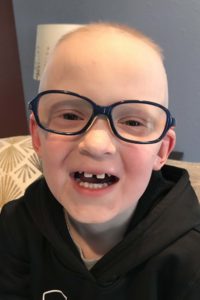
Sara Isaacs praises Dr. Knobloch for explaining that their family could expect for their son, Lars’ treatment plan.
“Dr. Knobloch was great at explaining procedures and a course of action for our son to me and my husband. “She was so understanding and patient with our five-year-old, who may not want to sit still, ask many questions, and wanted to play with the things around him. We are continuing our journey with our son with her.
One Stop Shopping
One of the strengths of our OSU Dental Treatment Center is its ability to provide a wide range of dental care. Whether you need dentures for your toddler, orthodontia to move teeth or dental implants for yourself, OSU can help.
“Our program can provide treatment from pediatric dentistry through full mouth implants and crowns,” Knobloch said. “We can provide pediatric care through our pediatric dentistry residents, orthodontic treatment, implant treatment including bone grafts and comprehensive prosthodontic services including crowns, bridges, partials, dentures, implants and full mouth reconstruction. We have specialists from the following disciplines: pediatric dentistry, orthodontics, prosthodontics, oral and maxillofacial surgery, periodontics, endodontics and dental anesthesia.”
Knobloch said that the greatest challenge is coordinating care amongst many different dental specialists and managing the transitional stages of care when a patient is still growing and changing.
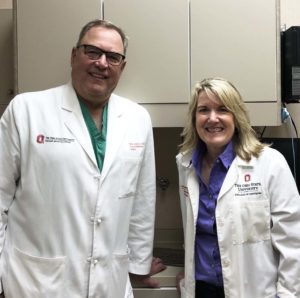
“Fortunately, I am surrounded by so many exceptional specialists at Ohio State that are equally invested in providing the best care we can. It is the support and expertise from a team of committed practitioners that makes this work. I am fortunate to have the commitment from Dr. Peter Larsen (Chair, Oral and Maxillofacial Surgery), Dr. Damian Lee (Program Director, Advanced Prosthodontics), Dr. Ana Mercado (Orthodontist, Nationwide Children’s Hospital), Dr. Toru Deguchi (Program Director, Orthodontics) and Dr. Janice Townsend (Chair, Pediatric Dentistry).”
Happy Families
Marci Mortensen has two boys affected by ectodermal dysplasia who started their started dental work at OSU around the age of seven, with Dr. Knobloch and her team.
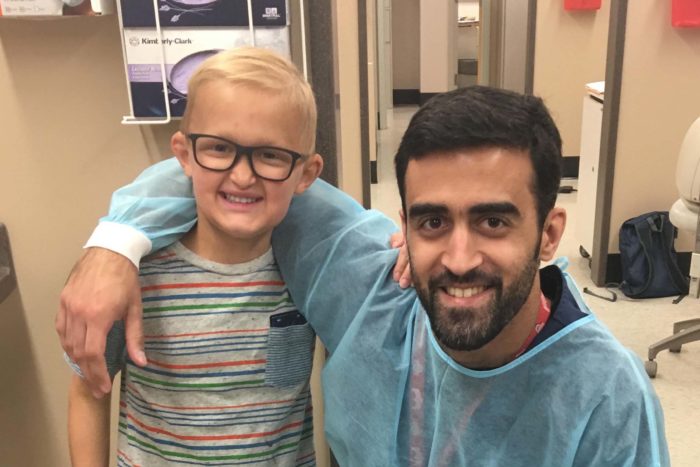
“They first mapped out where they wanted the dentures and implants. Dr. Knobloch’s team in prosthodontics works closely with the oral surgery team, and together they mapped out the implant spacing. Both boys had two bottom implants placed by Dr. Larsen at age seven. Then the dentures were created once the implants healed. We had a wonderful experience with Dr. Knobloch and her team. She has a great deal of experience working with individuals with ectodermal dysplasia, and she cares greatly about our community. We were lucky to have such a positive experience at OSU!”
Another NFED mom, Meredith Grime, is equally effusive about working with the dental team at OSU. Her son, Carter, has seen Dr. Knobloch since he’s a toddler.
“Carter was diagnosed with hypohidrotic ectodermal dysplasia around his first birthday. Just before his second birthday, we made our first visit to The Ohio State Dental School and Dr. Knobloch. It was obvious from our first interaction, kids like Carter have a special place in her heart. We asked about dentures for our two-year-old, she talked with us and with Carter.
Through her experience she could tell if we did them before he was ready it would be a battle, so we waited. We saw her for yearly check-ins, which were more like a family reunion. When Carter turned 11, he decided he was ready. We were assigned our very own grad student who measured, created, and fit his dentures, all while Dr. Knobloch looked on. Dr. Knobloch is extraordinary, her team is just as awesome, and we look forward to the next steps as Carter grows and changes!”
Another NFED mom, T.J., has a daughter who is a patient of Dr. Knobloch and had her first set of dentures made at the age of six, just before she started kindergarten.
“Dr. Knobloch and her team are extremely knowledgeable and caring. She walked us through each step that would take place before we began the process and then as the appointments started, always made sure my daughter was comfortable and understood what we were doing. It has been almost two years since my daughter’s denture was made. Any time an adjustment is needed, Dr. Knobloch does everything possible to fit us into her very busy schedule within the next day or so. She always goes the extra mile and helps when fit issues arise. We are blessed to have her team as a provider for our daughter.”
Sharing Her Wisdom
After two decades of treating individuals affected by ectodermal dysplasias, Dr. Knobloch has a few treatment tips for both her dental colleagues and for NFED families.
“The most exciting part of helping patients affected with ectodermal dysplasia is that every patient is different. Each patient brings a unique set of circumstances and this can create some challenges for the dental practitioner. The most important tip I can offer is to take a ‘can-do’ approach. The most common frustration we hear from patients is that they have seen multiple providers, and no one knows what to do.
Many times they have been told that nothing can be done until the child is old enough to begin a full mouth rehabilitation. If you are a provider that is comfortable treating the patient, be positive. Develop short-term and long-term goals. Talk to the patient about the different stages of care and what can be done along the way. If you are not comfortable providing care, reach out to the NFED for suggestions and make a thoughtful referral to someone you know can help.”
What Families Can Do
For a family, Dr. Knobloch says that the most important tip she can offer to the family is to find a provider that you feel comfortable with and don’t hesitate to be your child’s advocate.
“I always appreciate when a parent shares with me the struggles that they are observing at home because often times the kids don’t articulate these challenges in the treatment setting. I also appreciate patience during the transitional years. It can be challenging when a child enters a time of major growth and change and prostheses that once fit are no longer functioning well. These are times that are also challenging to the provider and know that we are working hard to find options to help. Every patient has a unique set of circumstances, so patience is always appreciated.”
Dr. Knobloch says that she’s learned more about the patient affected with ectodermal dysplasia than the dental treatment.
“I have learned that patients appreciate positivity and a ‘can do’ attitude. They appreciate hearing goals, both short-term and long-term. They understand that the final treatment plan may not be possible to define, especially if the patient is very young, but they do appreciate hearing goals and potential options that may be considered.
“Most patients are relieved to hear that we see patients regularly with ectodermal dysplasia and we are both comfortable and experienced treating patients with ectodermal dysplasia.”
The Cost Advantage
Besides seeing a dental team with experience, an additional advantage of going to the OSU Dental Treatment Center is that it will cost less.
According to Dr. Knobloch, “Because our treatment center is part of an educational program, our fees are less than private practice. In general, patients find that the fees are approximately 35% less than most private practices. We are also fortunate in the state of Ohio to have a program that accepts ectodermal dysplasia as an approved diagnosis through a state agency. For patients that qualify for this program, dental treatment is covered.
Ectodermal Dysplasias Treatment Fund
It turns out that the NFED is not the only one to have a Treatment Assistance Program that provides financial assistance for dental care. OSU has one, too. The fund can only be used for patients with diagnosed ectodermal dysplasia.
It is used for patients with a financial need in that they have no insurance or additional means to pay for treatment. There is no application process on the patient’s part. Patients are identified by the Ohio State University Treatment Center providers when developing the treatment plan and working through the process of cost and insurance authorizations.
“We also have an ectodermal dysplasia treatment fund that we are currently in the process of rebuilding,” Dr. Knobloch said. “This fund was initially started by a student I mentored for his capstone project. The fund has provided approximately $18,000 in treatment. We are currently working on rebuilding the fund.”
According to Dr. Knobloch, the Delta Sigma Delta Dental Fraternity approached her last fall about organizing a silent auction during an alumni event.
“All of the proceeds would be donated to the Ectodermal Dysplasia Treatment Fund here at the college,” Knobloch said. “I was so grateful and surprised. This is the first group of dental students that have expressed an interest in helping these patients. These students are pretty amazing. They went out and obtained donations and organized the nicest and most professional silent auction that raised $1,300.”
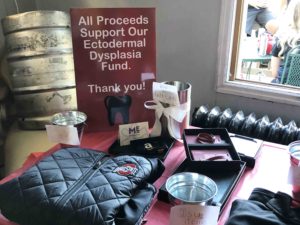
Kayla Bomske, the fraternity’s fundraising chair, said the group had planned to launch a fundraiser this spring to raise $5,000. Their project has been postponed to the fall since the university is shut down due to the COVID-19 pandemic.
“We are in the process of launching a crowd funding platform page, sort of like a GoFundMe, but it is through the university,” Bomske said. “All proceeds will go directly to the college’s Ectodermal Dysplasia Patient Fund. Through this page, we hope to raise awareness of the detrimental effects of ectodermal dysplasia and to help our treatment center begin to rebuild their treatment fund.”
Planning for the Future
Dr. Knobloch says she hopes to be able to offer their very young patients a more “child friendly” environment.
“Our facility is an adult clinic which would benefit from some minor modifications to one treatment operatory for a more welcoming environment for children. On a larger scale, my hope is to develop a website for our treatment center specific to ectodermal dysplasia treatment that can serve as a source of information for patients and dental practitioners.”
“The NFED is grateful to Dr. Knobloch, the dental team at OSU and the Delta Sigma Delta Dental Fraternity for their passion and desire to make a difference for our families,” Mary Fete said.
We could relate well when Dr. Knobloch talked about her experience with families with ectodermal dysplasias.
“What I love most about working with patients affected with ectodermal dysplasia is the genuine gratitude they have for the help you give them. They are the most resilient and gracious group of patients you will ever encounter.”
(If you are interested in being seen at the NFED Dental Treatment Center at OSU, start here.)
